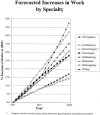The aging population and its impact on the surgery workforce
- PMID: 12894008
- PMCID: PMC1422682
- DOI: 10.1097/01.SLA.0000081085.98792.3d
The aging population and its impact on the surgery workforce
Abstract
Objective: To predict the impact of the aging population on the demand for surgical procedures.
Summary background data: The population is expanding and aging. According to the US Census Bureau, the domestic population will increase 7.9% by 2010, and 17.0% by 2020. The fastest growing segment of this population consists of individuals over the age of 65; their numbers are expected to increase 13.3% by 2010 and 53.2% by 2020.
Methods: Data on the age-specific rates of surgical procedures were obtained from the 1996 National Hospital Discharge Survey and the National Survey of Ambulatory Surgery. These procedure rates were combined with corresponding relative value units from the Centers for Medicare and Medicaid Services. The result quantifies the amount of surgical work used by an average individual within specific age groups (<15 years old, 15-44 years old, 45-64 years old, 65+ years old). This estimate of work per capita was combined with population forecasts to predict future use of surgical services.
Results: Based on the assumption that age-specific per capita use of surgical services will remain constant, we predict significant increases (14-47%) in the amount of work in all surgical fields. These increases vary widely by specialty.
Conclusions: The aging of the US population will result in significant growth in the demand for surgical services. Surgeons need to develop strategies to manage an increased workload without sacrificing quality of care.
Figures
Comment in
-
"I prefer old age to the alternative.": Maurice Chevalier, 1962.Ann Surg. 2003 Aug;238(2):178-9. doi: 10.1097/01.sla.0000080820.34756.1e. Ann Surg. 2003. PMID: 12894009 Free PMC article. No abstract available.
References
-
- Anderson RN, DeTurk PB. United States Life Tables, 1999. Natl Vital Stat Rep 2002;50(6):33. - PubMed
-
- Martin JA, Hamilton BE, Ventura SJ, et al. Births: final data for 2000. Natl Vital Stat Rep 2002;50(5). - PubMed
-
- Popovic J. 1999 National Hospital Discharge Survey: Annual Summary with Detailed Diagnosis and Procedure Data. National Center for Health Statistics, 2001;1. - PubMed
-
- Owings MF, Kozak LJ. Ambulatory and inpatient procedures in the United States, 1996. Vital Health Stat 1998;13(139). - PubMed
-
- Dennison C, Pokras R. Design and Operation of the National Hospital Discharge Survey: 1988 Redesign. National Center for Health Statistics; 2000. - PubMed
MeSH terms
Grants and funding
LinkOut - more resources
Full Text Sources
Other Literature Sources
Medical



